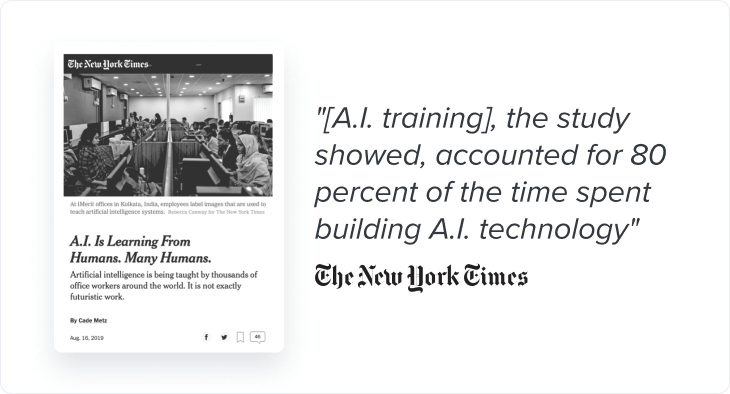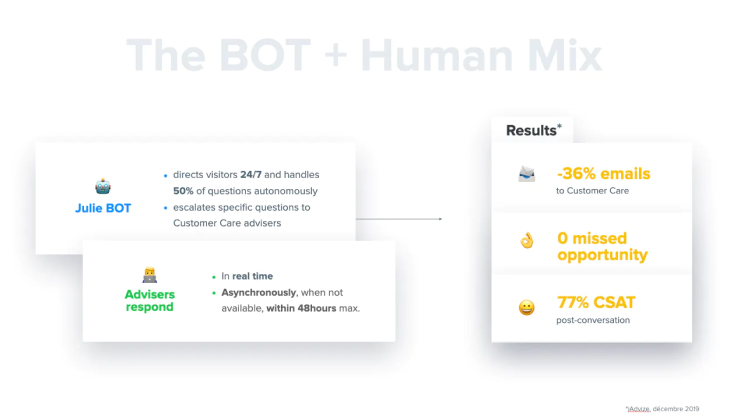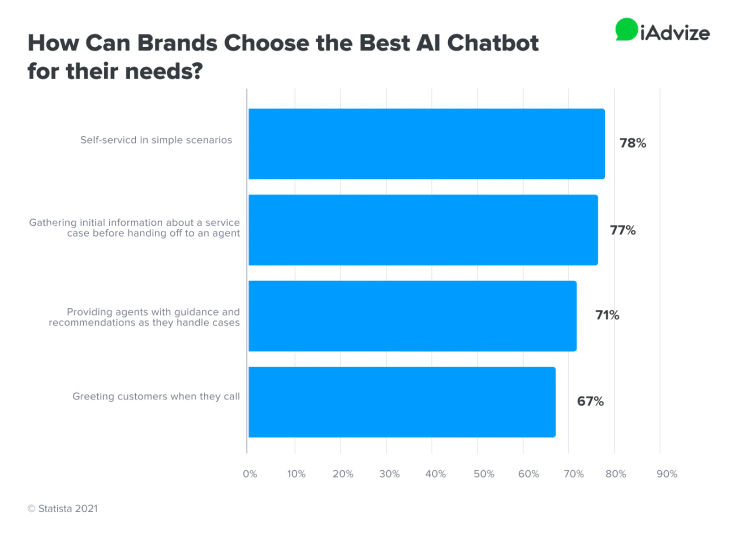Research conducted in 2021 indicates that the global market will hit
SUMMARY
- 1 • What Is Conversational AI?
- 2 • How Conversational AI Works
- 3 • Different Types of Conversational AI
- 4 • Advantages of Conversational AI
- 5 • Conversational AI Examples
- 6 • How Much Does Conversational AI Cost?
- 7 • An Effective Conversational AI Playbook
- 8 • The Conversational AI Market
- 9 • Conversational AI Chatbot
- 10 • Conversational AI Across Different Industries
- 11 • Conversational AI Platform

Want to save this guide for later?
Download a free PDF by filing out the form below.
1 • What Is Conversational AI?
This technology represents an innovative area of artificial intelligence focused on creating conversational agents capable of simulating human conversations fluidly and naturally. At the heart of this technology are advanced algorithms for natural language processing (NLP), allowing machines to understand and respond in various languages and dialects.
Scripted chatbots, while basic, pave the way for more sophisticated conversational interfaces, such as virtual assistants, which provide proactive help to users, thus reducing frustration and improving access to information. These systems rely on a vast knowledge base, often structured as FAQs, to self-train and continuously improve. The interest in conversational AI lies in its ability to provide a seamless user experience, mimicking the nuances of human exchanges, while being available 24/7.
The adoption of this technology is transforming interactions between brands and their customers by eliminating language barriers and personalizing support, thanks to AI tools that can learn and proactively adapt with each interaction.
2 • How Conversational AI Works
3 • Different Types of Conversational AI
The two main types of conversational AI technology are based on text and voice.
In the case of text-based artificial intelligence, the solution uses Natural Language Understanding (NLU) technology. NLU is a form of artificial intelligence that involves deciphering unstructured data and transforming this data into something that a digital system can interpret and process. The unique aspects of human input are standardized and classified, and then the textual input from the human user is translated into a machine-readable format.
The solution can be programmed to recognize keywords and phrases that facilitate interpretation and classification. Additionally, grammatical constructions can be pre-programmed to aid in data structuring. However, this alone does not constitute artificial intelligence. For the solution to be truly intelligent, it must act autonomously, developing its understanding based on the information it receives and the results of the responses it provides.
For voice-based artificial intelligence, NLU is also deployed. However, additional steps are necessary. Speech recognition technology, or Automatic Speech Recognition (ASR), must be used to recognize and interpret the audio input it receives.
In both cases, interpretation is followed by a process called Natural Language Generation (NLG), which enables the formulation of a response. The solution also draws data from the entire process, which will then be used to support ongoing development and machine learning.
4 • Advantages of Conversational AI
There are many benefits associated with this kind of AI.
Better Conditions for Your Support Team
The purpose of using conversational AI technology is not to replace your support team. Instead, it's to provide better working conditions for them, which will benefit your company as a whole. With a solution like this in place, your customer service teams will find that they have more time and resources to devote to other higher value tasks.
There's a degree of anxiety among workers concerning artificial intelligence. Around 27% of them have reported worries that AI will eliminate their jobs, rising to 37% among aged 18 to 24 year-olds. While this is a relevant fear, human customer support workers still have a major role to play in the business landscape. Training for new roles with the assistance of AI copilots will be an essential topic in corporate HR departments.
Increased Customer Satisfaction
Customer service has become a crucial area in modern businesses, with 90% of people surveyed in the United States citing customer service as a primary factor when choosing a company to do business with. Moreover, 58% of customers say they would switch to another company if faced with poor customer service.
This highlights two aspects of the service. The first: the quality of service received, and the second: the convenience of this service. Conversational AI solutions meet these needs by being available 24/7, ready to provide customers with the answers they need when they need them.
The powerful machine learning capabilities of conversational AI also come into play here. Statistics show that 66% of customers expect companies to demonstrate an understanding of their specific needs.
Here's an example of a conversational strategy powered by artificial intelligence:
Reduced Costs Across the Board
We'll examine the costs of these solutions in more detail in the section below. The ideal for optimized costs is to achieve the right balance between human agents and AI based chatbots.

With AI, you can reduce costs by filling the gap in service outside of business hours. Implementation requires additional investments, but this will result in long-term cost savings and the solution will pay for itself over time.
Support Diverse Customer Requirements
Statistics show that customers appreciate the idea of AI-based technology, provided that it delivers a high level of service and is deployed responsibly. Nearly 80% of customers are happy to share information as long as the data is relevant and improves the service. Moreover, 88% of consumers say they will trust a company if it commits to protecting personal information and not sharing their data without permission.
Ensured and transparent privacy is a crucial element of AI implementation. Compliance with standards is therefore essential.
Your customers are all different, and as a result, they have unique needs and expectations. Some will love the idea of a quick and easy interaction with AI, while others may prefer a direct interaction with a human advisor. Deploying your conversational agent solution in a triage role and forwarding relevant customer inquiries to human operators will help you effectively meet these needs.
Enhance Your Branding
As your artificial intelligence solution learns from its interactions with customers, you can still provide direct inputs to the solution. This will help you shape the application to reflect your company's unique branding.
A strong brand image is an important element of marketing, and your business must work hard to foster quick and effective connections. On average, it takes between five and seven impressions for customers to remember a brand, so you must ensure that your brand values are communicated at every interaction. Proactively disseminating a positive brand message through conversational AI is useful for achieving this.
Get to Know Your Customers
Your AI solution will feed on the data it collects from customers, develop its understanding of natural language through consumer inquiries, and refine the service it provides. However, that's not the full extent of the solution's potential. Conversational AI tools can also serve as valuable data resources for you and your company.
The more you deploy the technology over time, the more you will learn about your customers and the better you will be able to refine your marketing efforts. Remember to maintain a transparent approach to data collection, storage, and usage as mentioned above.
A credit institution found that due to the health crisis, consumers were postponing their purchasing plans. Through a detailed analysis of its most recent conversations, this client noticed that 50% of interactions involved a new credit application and that 30% came from prospects. These insights confirm the relevance of the current conversational strategy to best support visitors during times of crisis.
5 • Conversational AI Examples
Let's take a look at some key examples of this technology in action
Guiding Purchases With Advanced Language Processing
Thanks to advanced natural language processing, conversational AI systems understand customer queries in everyday language, allowing for smooth and intuitive interactions. This technology transforms the communication interface between customers and brands, providing a direct and personalized channel to answer questions, suggest products, and resolve uncertainties in real time.
By mimicking the personalized advice a shopper might receive in-store, conversational AI guides customers through their purchasing journey, from product discovery to decision-making, creating an online shopping experience that's as rich and satisfying as an in-person interaction.
Customer Support
The most widespread use of conversational AI is in customer support. In this role, an advanced conversational AI tool is particularly important, since dealing with shoppers can be tricky. Your customers expect high levels of service, which is why only the most powerful AI-based solutions are suitable for this purpose.
Internal Support
Your team members also need support. Tailored support for employees is essential to increase productivity and job satisfaction.
The Internet of Things (IoT) for Compatible Devices
Increasingly, consumers expect to interact directly with the hardware devices they use. Everything from personal assistants like Amazon's Alexa to smart devices like refrigeration units is now internet-compatible. Providing voice recognition software that works with users’ devices is an effective way to enhance the customer experience and provide reliable support wherever your consumers are.
Software Tools
Software tools have been utilizing conversational AI for several years, which is why applications like Microsoft Word and Google Translate can offer features like autocomplete and grammar checking. However, as technology advances, these solutions become increasingly powerful, and conversational AI with natural language processing can provide significant benefits to both your internal staff and customers.
6 • How Much Does Conversational AI Cost?
Like any revolutionary commercial technology, implementing conversational AI isn't free. However, as an automated solution, the operational costs of AI can be fairly minimal with long-term benefits.
It's difficult to say precisely how much your company can expect to save by adopting a conversational AI solution. The extent of savings depends on the balance you maintain between automated service solutions and human teams. On average, the direct cost of human labor ranges from $9.47 to $12.06 per hour, and it's significantly higher for outsourced and specialized services. Whether you handle service calls internally or through outsourcing will directly impact the savings you can expect to see, but the operational costs of AI will be substantially lower than this.
The cost of implementing the solution will vary depending on your delivery method. You might be able to implement AI through existing channels, such as WhatsApp or Messenger, which can reduce your initial costs. Adopting a dedicated conversational AI platform may increase costs.
7 • An Effective Conversational AI Playbook
Implementing conversational AI requires the right approach. This is why a playbook is essential to crafting an effective solution.
Identify Your Goals
What do you want to achieve with conversational AI? What industry are you in? What do your users expect from your e-commerce website? Answering these questions will help you identify the ideal outcomes for your artificial intelligence solution.
Define Ideal Interactions
You need to know what you're looking for in an AI solution. To do this, write down your ideal interactions with your customers and compare these with the outcomes generated by your solution.
Define Classifiers & Indicators
The AI solution will need to be able to identify the following:
- Domain — What type of query the user is inputting
- Intent — What output the user expects
- Entity — Specific tags used to build the response
- Role — The parameters of the response
For example, if a user asks, "How do I upgrade Product A?", the solution should be able to recognize that this is a product inquiry relating specifically to 'Product A', and that the user expects a description of how to perform an upgrade.
Build Dialogue Steps
The solution needs to know how to respond based on the classifiers and indicators mentioned above. This will be managed by the dialogue manager integrated into the solution, but it must be programed before the conversational machine learning process of the AI begins.
Connect A Knowledge Base
While the solution learns over time by increasing its understanding, there must always be an underlying knowledge base. Following the example above, the conversational AI application will need a source from which to draw the upgrade tutorial.
Train Classifiers & Indicators
To make machine learning as effective as possible, the solution will need to be trained on relevant classifiers and indicators. This is an ongoing process that will become automated over time as the solution develops its own contextual knowledge.
8 • The Conversational AI Market
The conversational artificial intelligence market is expanding rapidly. Research conducted in 2021 indicates that the global market will reach $46.29 billion by 2028, representing a compound annual growth rate (CAGR) of 30.75% over the next seven years. This is a significant recalibration compared to earlier estimates. Another study from 2019 valued the global market at $4.2 billion, rising to $15.7 billion by 2024 with a CAGR of 30.2%.
Another study put the global market size at $7.32 billion in 2020, growing to $19.1 billion by 2026 with a CAGR of 31.3%. This study identified the North American market as holding the largest market share across the world. But, it also found that growth in the Asia Pacific region is outpacing North America.
While these studies do provide a disparate selection of results, the indications are largely similar. This is a healthy market and one which is experiencing huge gains as we move forward through 2021 and beyond.
9 • Conversational AI Chatbots
A conversational AI-powered chatbot is the cornerstone of the artificial intelligence market, but what exactly does this type of solution entail?
A conversational AI chatbot derives its technology from artificial intelligence, receiving user inputs and providing outputs autonomously. It relies on technologies like NLU (Natural Language Understanding), ASR (Automatic Speech Recognition), and NLG (Natural Language Generation) to learn more about the human user it interacts with and to provide appropriate responses.

Today, for brands that want to go further in transforming their customer experience, implementing a conversational AI chatbot is a great place to start.
This generation of conversational AI has already been surpassed by next-generation virtual assistants. These copilots, fueled by Large Language Models (LLMs), are connected to brand ecosystems and capable of responding without prior training. These copilots significantly increase conversion rates and double customer satisfaction compared to NLU chatbots.
Brands must ask several questions to choose the solution best suited to their conversational strategy.
- What's your level of customer experience quality and conversational maturity?
- What's the purpose of your bot? Is it for self-service? Information gathering?
- What are your organizational goals?
10 • Conversational AI Across Industries
This technology has many applications for different industries. Let's explore a few examples.
Conservational Artificial Intelligence in Retail
Conversational AI is used in retail to provide information and advice to customers during the product selection phase. While some consumers may decide to purchase a product with minimal support, others may need more support and guidance along the way.
Conversational AI in the Service Industry
In the service industry, conservational AI is sometimes used to provide additional support to customers post-purchase. This may include technical support for subscription-based customers and other forms of customer assistance and support. Our research suggests that as many as 30% of contact page visitors request to be contacted via a messaging channel.
Conversational AI in the Travel and Tourism Industry
In the travel and tourism industry, conversational AI is predominantly used to provide real-time assistance to customers during their travels. It can also be used to interpret user inquiries, translating these into appropriate travel packages or other offers. Our clients in the tourism and travel industry nearly double their conversion rates after deploying iAdvize messaging solutions.
11 • Conversational AI Platforms

At iAdvize, we're pioneers of conversational commerce and leaders in Trusted Generative AI for E-commerce. We deploy AI copilots powered by generative AI that are reliable, connected, and fully compliant, enabling a 10x increase in online conversion rates while automating up to 75% of customer interactions. Innovative brands like Cdiscount, Samsung, and Sideshow use iAdvize to simplify the shopping experience.
Brands use iAdvize Copilot™ to enhance the performance of key e-commerce players, including:
- The customer
- The customer service agent
- The analyst
AI-powered copilots are connected to a brand's ecosystem and data, so that they comply with all your brand rules and data laws and regulations. This also makes them entirely controlled by you, ensuring the reliability and accuracy of their responses to customer questions.
Copilots are easy to install, are self-training, and can be tested and ready to launch in just two weeks. Get a glimpse of the e-commerce user experience with an AI Copilot:
Want to save this guide for later?
Download a free PDF by filing out the form below.

.png)
.png)








